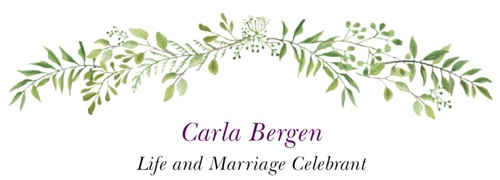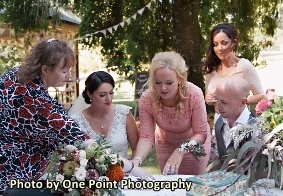
Home | Weddings | Other Ceremonies | Legal Requirements | Fees | Testimonials | Contact
Legal RequirementsIt is very important to ensure that all requirements are met. This includes: Eligiblity and consent
|
|
Eligibility and consentAge
Marital status
Prohibited relationshipsMarriages cannot take place between:
This includes adopted children, even if they have since been adopted by different parents. ConsentIf:
then consent is not considered to be a real consent and the marriage is void. PaperworkNotice of Intended Marriage (formerly known as Form 13)The first document you will need to complete is the Notice of Intended Marriage (or “NOIM”). This needs to be lodged with the celebrant no less than one month and no more than eighteen months prior to the marriage being solemnised, and is often completed at the first meeting with your celebrant. Parties must provide proof for the questions asked in the NOIM so will need to provide certain documents –
NOTE: If a party to a marriage was born overseas and does not have, nor is able to obtain, a Birth Certificate, they will need a passport issued by the government of the country in which they were born. If that is not possible, they will need a statutory declaration meeting the requirements of Section 42 of the Marriage Act 1961. These documents MUST be produced before the marriage can take place so it is essential that couples give themselves adequate time to acquire them if they do not yet have them or have misplaced them. The documents can be provided in person, or in some instances electronically - more information can be found by reading this fact sheet in conjunction with additional information here. About the notice requiredUnless there are specific circumstances, both parties are required to give a minimum one month notice. Happily Ever…. Before and After (formerly known as Form 14a) and Family Relationship ServicesBy law, as soon as practicable after receiving the NOIM, a celebrant must provide prospective couples with a brochure, “Happily Ever… Before and After”. This provides a range of information, from services that may assist with pre and post marriage education, to other considerations, such as changing of names, tax, citizenship, benefits and wills. Declaration of No Legal Impediment (formerly known as Form 14)Prior to the wedding, both partners will be required to sign a declaration, stating that they believe there is no legal impediment to the marriage between each other. It will be on the back of another form (Official Certificate of Marriage) that will be completed following the solemnization. Certificate of Marriage – Form 15 - for the coupleThis is the “pretty one” that appears in many wedding photos and that the couple takes home after the wedding. It contains the details of the celebrant, the date and place of the wedding, names and signatures of the couple and signatures of the witnesses, and is completed directly after the solemnization. Official Certificate of Marriage (formerly known as Form 16)The official certificate of marriage, which contains the details required to register the marriage. This is also completed directly after solemnization of the marriage. There are two copies -
SignaturesAll signatures should be the usual signatures of the couple, witnesses and celebrant. Lodgement of the paperworkOnce the wedding is completed, the celebrant will provide all required paperwork to the appropriate authority in the state or territory where the ceremony took place, within 14 days. This will include:
The CeremonyAlthough nearly all of the ceremony can be tailored to meet the wishes of the couple, certain wording must be included to meet the legislative requirements of the Marriage Act 1961. Couples must also have two witnesses aged (or who appear to the celebrant to be aged) 18 years or over, and will need to provide the full names of these witnesses to the celebrant. For the celebrant – the Monitum (Subsection 46(1) of the Marriage Act 1961)The following wording, known as the Monitum, must be spoken by the celebrant, prior to the vows below Before you are joined in marriage in my presence and in the presence of these witnesses, I am to remind you of the solemn and binding nature of the relationship into which you are now about to enter. Marriage, according to law in Australia, is the union of two people to the exclusion of all others, voluntarily entered into for life." For the couple – the Vows (Subsection 45(2) of the Marriage Act 1961)Each person will need to say the following words: “I call upon the persons here present to witness that I, A.B. (or C.D.), take thee, C.D. (or A.B.), to be my lawful wedded wife / husband / spouse.” This will often be in the form of a “repeat after me” led by the celebrant. Please note – some of the required wording can be changed slightly, but only if the new wording retains the same meaning. Any words added to lengthen the vows cannot contradict them. Celebrant requirementsThe celebrant must:
Interpreters and translatorsA celebrant must ensure to the best of their ability that the information they receive is correct, and that the couple both fully understand the paperwork they are completing and the commitment they are making. If documents are provided in a language other than English, the celebrant should advise the couple to provide a formal translation by an accredited translator. Should a celebrant feel it is necessary, they can request the services of an interpreter prior to and during the ceremony. This may be in regards to the spoken word or signed language (Auslan). The interpreter must be a person other than a party to the marriage. The celebrant must not solemnise a marriage at which the services of an interpreter are to be used unless the celebrant has already received a statutory declaration (on the prescribed form) by the interpreter stating that they understand, and are able to converse in, the languages in respect of which they are to act as interpreter. Immediately after the ceremony, the interpreter must furnish to the celebrant a certificate of the faithful performance of his or her services as interpreter. The certificate must be on the prescribed form. The statutory declaration and certificate must be forwarded to the appropriate registering authority with the other required documentation. The National Accreditation Authority for Translators and Interpreters (NAATI) can assist in locating required services: http://www.naati.com.au/ As you can see, there are many steps and considerations along the way! I will do my best to ensure that you are kept fully up to date and made aware of the importance and relevance of each step as they are completed.We can work together to ensure that the legal obligations are met while still making the ceremony as personalised and special as you desire.References:
© Carla Bergen 2014-2024 |
|

